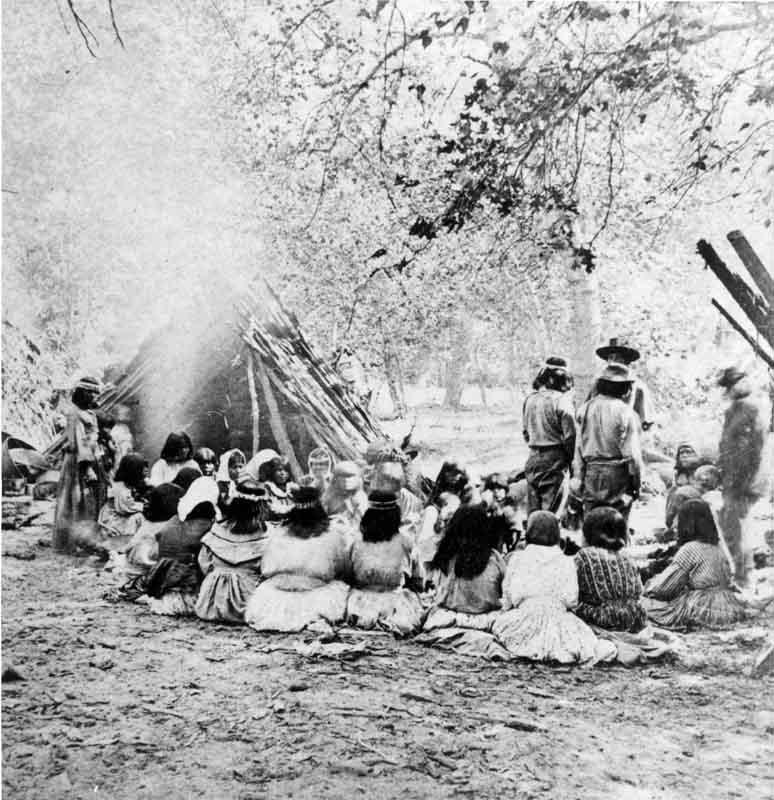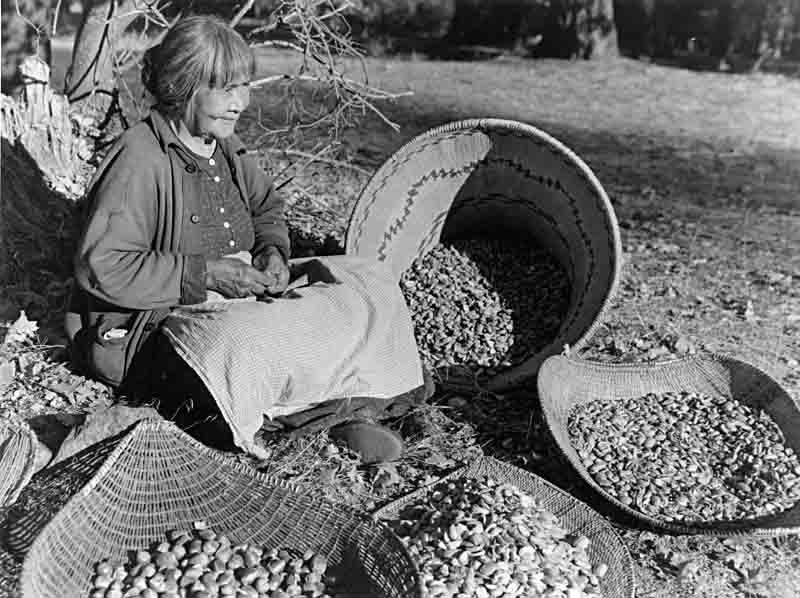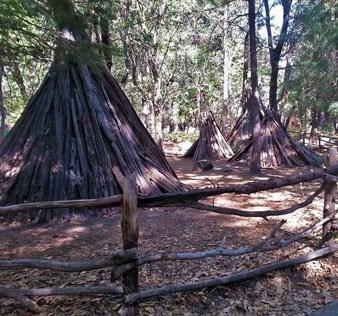
6 minute read
THIS IS INDIAN LAND: YOSEMITE NATIONAL PARK
B Y J E S S I C A M E H T A
Cover Photo: Susie & Sadie McGowan- Mono Lake Paiute. Photo: NPS
Advertisement
The Southern Sierra Miwuk Nation (SSMN) consists of the indigenous inhabitants of what is often today called Yosemite National Park and Mariposa County, California. The noun Miwuk, sometimes spelled Miwok in English, means “ person. ” The Miwuks spoke seven dialects derived from Penutian. Prior to the 1848 Treaty of Guadalupe Hidalgo, the Southern Sierra Miwuks had thriving villages throughout the region. Immediately following the treaty between the United States and Mexico, gold was “discovered” in the area. The Miwuks were ranchers, and settlers eager to take advantage of the rich natural resources. The newly established State of California (1850) funded private militias to eradicate the SSMN through a systematic process of destroying villages, food resources, enslavement, and murder. Throughout 1851 1852, – treaties were signed between the United States, the Miwuks, and other regional tribes in an effort to end the violence. These treaties specified tracts of land within the Miwuk ancestral territory that were to be reserved and protected for the Miwuks.

Group of about twenty-six Native Americans seated and standing beside a cedar bark structure, near the Merced River, Yosemite Valley, 1872.
NPS
The U. .S government also agreed that these “ reservations ” were to be supplied with a number of support systems, including protections for the Native inhabitants. In exchange, the Miwuks and neighboring tribes seceded thousands of acres. Like many such “ agreements ” between Native American tribes and the U.S. government, the details of these treaties were never fully revealed to the Miwuks. California senators opposed ratification of the 19 treaties initially signed between the state and various U.S. tribes, including the Miwuk tribe. This opposition was supported by the U.S. Senate, rendering the Miwuks and many other tribes throughout the state without a home. Without the treaty, the SSMN was deemed unrecognized as a tribe by the federal government. Extreme poverty by this breach led to starvation, illness, and mass deaths of Native people around the state. Those who survived did so by sheer grit, sharing resources with neighboring tribes, and seeking refuge in remote areas of California. One of the most remote areas in California 180 years ago was the Sierra Nevada Mountains, today known as Yosemite National Park.

Maggie Howard, also known as Tabuce (1870-1947) seated on ground preparing acorns, surrounded by large baskets of acorns. Mono Lake Paiute
Finding a Retreat in “Yosemite”
Thanks to the isolation of the mountains, coupled with the fact that it was home to several ancestral villages, the Miwuks were able to rebuild their home and community even in the face of violence and colonization efforts nearby. The tribe was able to harvest traditional foods and medicines once again, thriving for nearly 50 years. These foods included fresh, local ingredients and resources such as acorns (which were turned into meal), venison, elk, small game, black bears, and fowls. Fish were a key part of the Miwuk diet, particularly shellfish and trout. As a hunter-gatherer- tribe, the Miwuks enjoyed a rich diet of berries, greens, mushrooms, and bulbs. This revitalization came to an abrupt end at the turn of the century when the federal government claimed control of the area and named it part of the National Parks System (NPS). Between 1900–1910, all of the SSMN sites throughout “Yosemite ” were removed—save for one tent village of 15 cabins.
The Miwuks were forced to consolidate and live in this small village while the NPS began promoting what was now a “Park” in earnest. The Miwuks were used as a promotional tool and proved very useful at increasing tourism. This involuntary and unbalanced relationship continued until 1969 when the Miwuks were forced out of their last remaining village by the NPS. Shortly after this eviction, the village was destroyed in a firefighting test administered by the NPS. A single cabin did survive, owned by the Tucker family. Today, it is a wildlife management office.
Now legally homeless, the Miwuks renewed their fight to be recognized as a tribe by the U.S. government. They created the American Indian Council of Mariposa County in 1972. As a non-profit, the Miwuks could apply for grants and have a legal foundation to establish economic and educational programming. When the American Indian Religious Freedom Act was signed in 1978, the SSMN had legal protection to prioritize cultural preservation activities. This led to new, annual events held by the SSMN in Yosemite National Park and a new relationship with NPS. The SSMN and NPS began working together and established the Indian Village of Ahwahnee within the park, which is also the site of one of the tribe's ancestral villages.
Today, the Miwuks continue to fight for federal tribal recognition. They were one of the first tribes to file an acknowledgment petition with the Department of the Interior in 1982. Since that time, the SSMN has filed thousands of documents to the Interior Office of Federal Acknowledgement (OFA) to support their history, heritage, and lineage that connects today’s descendants to their ancestors. These efforts came to no avail until very recently. In 2018, a formal review was finally held; however, the request was denied. The Assistant Secretary of Indian Affairs released a “Proposed Finding ” that stated today’s descendants “ at present” do not exist as a distinct group. Currently, the Miwuk descendants are filing petitions to appeal this decision. This denial does not align with their history, their relationship with nearby tribes (many of which are federally recognized), or with their current relationship with NPS and Yosemite National Park. Both regional tribes and NPS’ Yosemite National Park do consider the descendants of Miwuks a “distinct Indian community. ”

Chris Brown (Chief Lemee)-born in Yosemite, Claimed to be Miwuk
NPS
The process to request acknowledgment from the OFA is unsurprisingly one drowning in red tape and bureaucracy. There are seven facets to federal acknowledgment, a process that was created via a settler lens. After eight years of being considered under “ active consideration, ” the request was denied because one of the seven criteria was deemed unmet. Such denial does not align with the precedence set by other, nearby tribes having achieved federal acknowledgment. Three letters were submitted publicly by former OFA staff that questioned this decision, with one letter penned by a person who served on the review team.
SSMN at Yosemite Today
While the fight to achieve federal recognition continues, the relationship between the SSMN descendants and Yosemite National Park continues to improve. Today, cultural events continue in the Park under the guidance of Native elders. This includes the famous Bear Dance ceremony, an annual event that draws a large crowd including several members of neighboring tribes from around the state. For 30 years, the Southern Sierra Miwuk Nation and Yosemiteassociated tribal nations have hosted an annual walk along historic trails, honoring their ancestors and the trials they endured. This spiritual event is open to everyone and encourages a reflection on indigenous homelands as the group walks and sings in the steps of those who walked before them. Every summer, the BIG TIME celebration at Yosemite Valley Tribal Village always draws a crowd to see traditional dancers from around California perform.
However, for many Miwuks, the most exciting project happening in the area is the rebuilding of the village that was almost entirely destroyed in 1969. According to Scott Gediman, a spokesperson for Yosemite National Park, “Telling the cultural history and telling the story about the Native Americans is equally as important is planned near Campground 4. The new village will feature umachas, a type of traditional, triangular house made of cedar bark. There will also be a sweat lodge and roundhouse in the village to serve as the spiritual core for local tribes. This rebuild project is managed by the American Indian Council of Mariposa County. Now an elder in the community, 80-year-old Bill Tucker is active in the rejuvenation and rebuilding efforts in Yosemite National Park. His family cabin is planned to be moved to a new, nearby site within the Park. “This is home, ” he says.
Photos from NPS






